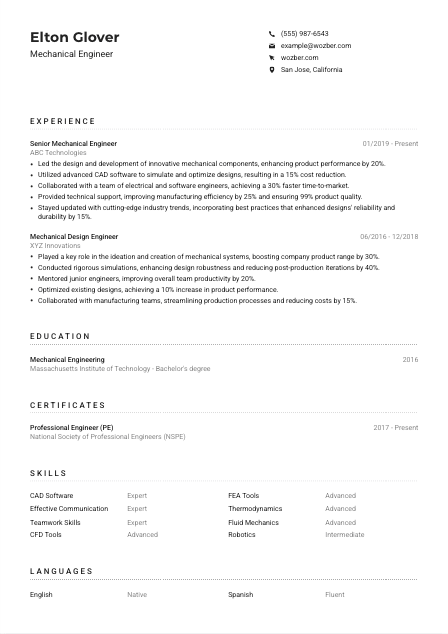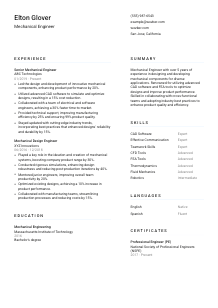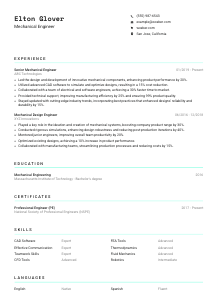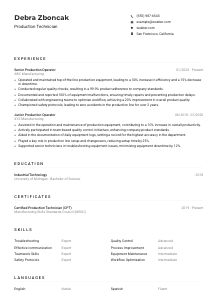Mechanical Engineer CV Example
Designing contraptions, but your CV's gears are grinding? Dive into this Mechanical Engineer CV example, engineered with Wozber free CV builder. Explore how to precision-fit your engineering finesse and project prowess to mesh with job requirements, setting your career trajectory as smooth as a well-oiled machine!

How to write a Mechanical Engineer CV?
Eager to revamp your Mechanical Engineer CV or craft a new one from scratch? Perfect! In the dynamic field of Mechanical Engineering, where precision and innovation drive success, your CV is your blueprint to career advancement. Utilizing Wozber's free CV builder, this comprehensive guide will steer you through tailoring your CV to meet and exceed the expectations of your dream job. Let's engineer a CV that powers up your career trajectory with precision and flair!
Personal Details
Fine-tuning the Personal Details section of your CV is like setting the foundation for a robust mechanical system. It's about creating a reliable first impression that firmly aligns with the Mechanical Engineer position you're aiming for. With accuracy and a touch of personal branding, let's engineer this section to get you noticed.
1. Emphasize Your Name
Think of your name as the title of your professional blueprint. Ensure it features prominently, adopting a clear, professional font. This isn't just about aesthetics; it's about making your name memorable at first glance.
2. Engineering Your Position
Directly beneath your name, clearly state your desired job title - "Mechanical Engineer." This immediate declaration tunes the reader into your career objectives and showcases your alignment with the position.
3. Essential Contact Infos
Accuracy is key in engineering, and the same goes for your contact information. Double-check your phone number for typos, and use a professional email format like firstname.lastname@mail.com to keep things sleek and straightforward.
4. Location, Location, Location
"Must be located in San Jose, California," the job description says. Highlighting San Jose as your location assures potential employers you're ready to roll without the hassle of relocation.
5. Professional Profiles
Consider adding your LinkedIn profile or a personal website showcasing your projects. This gives recruiters a deeper dive into your professional world, making your application stand out.
Takeaway
Your Personal Details section is the polished introduction to your professional persona. Tailored accurately, it not only meets the basic requirements but also serves as an inviting handshake into your career narrative. Let's make sure it's perfectly engineered to roll out the red carpet for your expertise.





Experience
The Experience section is where your engineering career takes center stage. It's your chance to showcase projects completed, problems solved, and innovations introduced. Just like otimizing a design for performance, let's optimise your experience to highlight your fit for the Mechanical Engineer role.
- Led the design and development of innovative mechanical components, enhancing product performance by 20%.
- Utilized advanced CAD software to simulate and optimise designs, resulting in a 15% cost reduction.
- Collaborated with a team of electrical and software engineers, achieving a 30% faster time‑to‑market.
- Provided technical support, improving manufacturing efficiency by 25% and ensuring 99% product quality.
- Stayed updated with cutting‑edge industry trends, incorporating best practices that enhanced designs' reliability and durability by 15%.
- Played a key role in the ideation and creation of mechanical systems, boosting company product range by 30%.
- Conducted rigorous simulations, enhancing design robustness and reducing post‑production iterations by 40%.
- Mentored junior engineers, improving overall team productivity by 20%.
- Optimised existing designs, achieving a 10% increase in product performance.
- Collaborated with manufacturing teams, streamlining production processes and reducing costs by 15%.
1. Blueprint of Requirements
Kick off by parsing the job description for key requirements. Look for experiences in your career that align with phrases like "design and develop mechanical components" or "utilize advanced CAD software."
2. Structure of Success
Lay out your experience in a reverse-chronological order. For each position, start with your title, the company's name, and the period of your employment. This structure offers a clear, logical flow of your career progression.
3. Crafting Achievements
For every position, articulate your achievements that mirror the job requirements, such as leading the design of innovative components or otimizing designs for cost reduction. Remember, specificity attracts attention!
4. The Power of Numbers
Quantify your achievements whenever possible. Whether it's enhancing performance by 20% or reducing costs by 15%, numbers provide a tangible measure of your contributions and success.
5. Relevance Over Quantity
Aim for impact, not length. Include experiences that resonate most with the Mechanical Engineer role. It's about making every point a testament to why you're the ideal candidate for the job.
Takeaway
Your experience section is the engine of your CV, driving home your fit for the Mechanical Engineer position. Tailor it with precision, ensuring each achievement demonstrates your engineering prowess and alignment with the role's requirements. Let your career's narrative convey your readiness to tackle new challenges.
Education
In the Mechanical Engineering field, your educational background is not just a prerequisite; it's the backbone of your expertise. Molding this section to reflect your qualifications and alignment with the job not only meets the requirements but also underlines your foundation in the field.
1. Identifying Core Requirements
The job calls for a "Bachelor's degree in Mechanical Engineering or related field." Make sure your educational qualifications directly meet this requirement, placing it prominently on your CV.
2. Format for Clarity
Present your education in a straightforward manner: Degree, Field of Study, Institution, and Graduation Date. This clear structure makes it easy for hiring managers to see you've got the academic chops for the job.
3. Degree Details
If your degree directly aligns with the job requirement, such as a Bachelor's in Mechanical Engineering, spell it out exactly as it is. Matching the language of the job description to your CV ensures ATS compatibility.
4. Relevant Courses and Projects
Especially for recent graduates or those new to the field, highlighting specific courses or projects that align with mechanical engineering can demonstrate your practical knowledge and eagerness to dive into the profession.
5. Educational Achievements
Did you excel academically or participate in engineering clubs or societies? Mention these accomplishments to show your dedication and active involvement in your field of study.
Takeaway
Your education section underpins your CV, reinforcing your qualifications and readiness for the Mechanical Engineer role. Craft it to showcase the depth of your knowledge and your steadfast footing in mechanical engineering. It's a testament to your commitment to the discipline.
Certificates
In the ever-evolving field of Mechanical Engineering, certifications can be powerful proof of your skills and dedication to professional growth. Let's identify and present your certifications in a way that adds undeniable value to your CV.
1. Aligning with Job Needs
Start by reviewing the Mechanical Engineer job description for any mentioned certifications. If none are specified, consider industry-recognized ones that demonstrate your expertise and commitment, such as a Professional Engineer (PE) license.
2. Highlighting Relevant Certifications
Display certificates that are directly relevant to the Mechanical Engineering field. Prioritize quality by listing those that bolster your application the most prominently.
3. Dates Matter
Include the acquisition or validity dates of your certifications to demonstrate your ongoing commitment to professional development. It's an effective way to show you're up to date with industry standards.
4. Continuous Learning
The field of Mechanical Engineering is dynamic. Indicating that you are continuously updating your knowledge through certifications not only demonstrates your enthusiasm but also your adaptability to new technologies and methodologies.
Takeaway
Certifications on your CV are like quality seals on your professional capabilities. They underscore your specialized knowledge and ongoing commitment to excellence in the Mechanical Engineering field. Strategically selected and presented, they significantly bolster your candidacy.
Skills
In the precision-driven world of Mechanical Engineering, your skills section is your professional toolkit displayed in full view. Here, we'll align your skills with the job requirements, ensuring this section highlights your engineering acumen and problem-solving prowess.
1. Decoding Job Skills
Scour the job description for specific skills like "proficiency in CAD software" or "strong knowledge of fluid mechanics." These are the tools of your trade that you'll want to highlight prominently on your CV.
2. Matching and Showcasing
Directly match your skills to those listed in the job description. Consider using the same language to ensure ATS compatibility and to make it unequivocally clear to the hiring manager that you possess the required skills.
3. Tailored Presentation
Resist the temptation to list every skill you possess. Focus on those most pertinent to Mechanical Engineering, ensuring your CV remains relevant and impactful. Highlighting skills from CAD software proficiency to teamwork underscores your comprehensive capability.
Takeaway
The skills section of your CV is a showcase of your professional competencies. Carefully tailored to the Mechanical Engineer role, it affirms your expertise and readiness to contribute. Let this section serve as a compelling summary of your professional toolkit, polished and ready for action.
Languages
In the diverse and often global field of Mechanical Engineering, the ability to communicate in multiple languages can be a definitive edge. Let's navigate positioning your language skills as an added bonus, enhancing your eligibility for the role.
1. Language Requirements
The job description clearly requires "English speaking and comprehension skills." Your CV should reflect your proficiency in English at the top, specifically if it's native or fluent to meet this fundamental requirement.
2. Additional Languages
Even if not specifically required, additional languages speak to your flexibility and global readiness. List these languages in descending order of proficiency, demonstrating the breadth of your communication skills.
3. Honesty in Proficiency
Clearly distinguish your level of proficiency for each language listed using terms like native, fluent, intermediate, or basic. This clarity offers employers a precise understanding of your communication capabilities.
4. Global Market Readiness
For roles that hint at or directly involve international interaction, mentioning multiple language proficiencies can significantly bolster your application, showcasing you as a well-rounded, globally-aware candidate.
5. Continuous Learning
Languages, much like technical skills, require ongoing refinement and learning. Indicating your commitment to improving your language skills can reflect positively on your overall dedication to personal and professional growth.
Takeaway
Your linguistic abilities are not just personal assets; they are professional tools that can open doors in the Mechanical Engineering field. Highlighting your language skills, especially when tied to job requirements or global readiness, can set you apart as a candidate of choice. Let your CV speak volumes of your diverse capabilities.
Summary
The summary section of your CV is where you distill your professional essence. For a Mechanical Engineer, it's about concisely articulating your overarching expertise, experience, and the unique value you bring to the table. Let's craft a summary that encapsulates your engineering capabilities and career achievements with precision.
1. Blueprint of Your Career
Start your summary by framing your career in broad strokes. Mention your years of experience and specialized areas within Mechanical Engineering, connecting them directly to the job you're seeking.
2. Highlighting Key Achievements
Next, spotlight a few significant achievements or areas of expertise, such as your prowess in using advanced CAD software or your experience in leading cross-functional project teams. Make it clear that you're not just a participant but a driver of success.
3. Matching Job Descriptors
Weave in language and skills directly from the job description, such as "proficiency in analyzing, simulating, and otimizing designs using FEA and CFD tools" to mirror the job's requirements and underscore your eligibility.
4. Concisely and Powerfully
Keep your summary concise yet powerful. Aim for a tight, punchy few sentences that leave no doubt about your qualifications and eagerness to bring your engineering expertise to the role.
Takeaway
Think of your summary as the high-impact elevator pitch that succinctly conveys your professional narrative. Tailored explicitly to the Mechanical Engineer role, it should resonate with hiring managers, compelling them to see you as the ideal fit. With precision and clarity, let your summary be the catalyst that propels your CV to the top of the stack.
Setting the Stage for Success
Congratulations on navigating the intricacies of crafting a specialized Mechanical Engineer CV! With each section finely tuned and tailored using Wozber's free CV builder, including ATS-friendly CV templates and ATS optimisation tools, you're well on your way to making a memorable impression. Remember, your CV is not just a document; it's a reflection of your professional journey and ambition. Harness these insights, leverage Wozber's ATS CV scanner, and stand ready to embark on your next career milestone with confidence!

- Bachelor's degree in Mechanical Engineering or related field.
- Minimum of 3 years of experience in mechanical design and CAD software.
- Proficiency in analyzing, simulating, and optimizing designs using FEA and CFD tools.
- Strong knowledge of thermodynamics, fluid mechanics, and robotics.
- Effective communication and teamwork skills to collaborate with cross-functional teams.
- English speaking and comprehension skills required.
- Must be located in San Jose, California.
- Design and develop mechanical components, systems, and processes for various products and applications.
- Conduct simulations, testing, and prototypes to ensure design and performance specifications are met.
- Collaborate with multidisciplinary teams, including electrical and software engineers, to ensure holistic product development.
- Provide technical support for product manufacturing, ensuring quality, efficiency, and cost-effectiveness.
- Stay updated with the latest industry trends, technologies, and best practices to continually improve designs.















